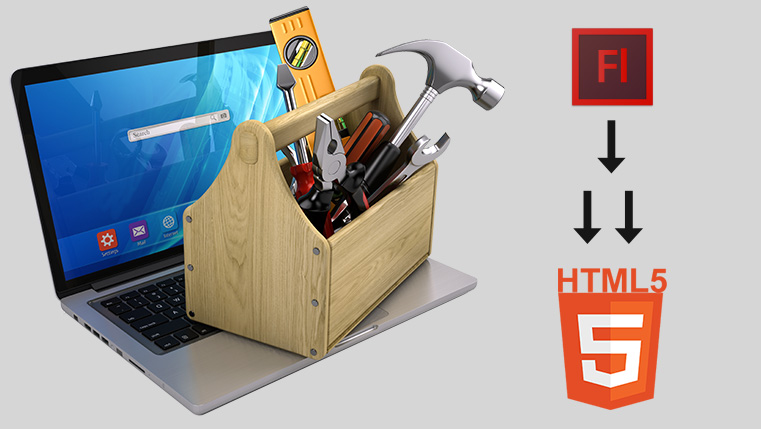7 Out of the Box Authoring Tools for Flash to HTML5 Conversion

With Adobe Flash all set to be knocked out from eLearning development, many organizations are either contemplating or have already planned for Flash to HTML5 conversion for their existing online training programs. Needless to say, the choice of authoring tool is important when you plan to convert your existing Flash-based eLearning to HTML5.
Alternative Authoring Tools for Flash to HTML5 Conversion
Articulate Storyline, Adobe Captivate, and Lectora Inspire are some of the popular authoring tools for Flash to HTML5 conversion. Here are 7 other authoring tools that can be leveraged for Flash to HTML5 conversion.
- dominKnow | One
- Adapt
- Elucidat
- SmartBuilder
- gomo
- Easygenerator
- Composica
Articulate Storyline, Trivantis Lectora, Adobe Captivate and iSpring Suite are a few of the popular authoring tools in Flash to HTML5 conversion of eLearning courses. There are other authoring tools too, each with its own set of pros and cons. Interested to know about the other authoring tool options for Flash to HTML5 conversions? Here’s our take on some of the choices that are available.
1. dominKnow | One
dominKnow | One has emerged as the dark horse among eLearning authoring tools. A lot of improvisation has been done on authoring tools from the dominKnow platform. The latest, dominKnow | One combines the powerful course authoring features of dominKnow Claro with the responsive feature offered by dominKnow Flow, along with built-in support to create software simulations.
| Pros | Cons |
|
|
Going by the speed at which this tool is undergoing updates, we can expect dominKnow to come up with updated features soon.
2. Adapt
Adapt is an open-source rapid authoring tool that can be used by non-technical people who want to develop eLearning courses without having to write code.
| Pros | Cons |
|
|
Because Adapt is open source, developers can extend the code and build their own versions of the authoring tool.
3. Elucidat
Elucidat is a user-friendly tool that can be leveraged for Flash to HTML5 conversion. It’s easy enough for developers who are just getting started with eLearning development.
| Pros | Cons |
|
|
Since Elucidat is cloud-based, it supports collaborative development. But then, it does not offer all the features that you find in authoring tools such as Articulate Storyline.
4. SmartBuilder
SmartBuilder is a tool that’s capable of creating complex eLearning that integrates multimedia, text, interactions and quizzes. It is best suited for eLearning developers with some experience in content authoring.
| Pros | Cons |
|
|
SmartBuilder lacks a screen recording and video editing tool. So, if you do not have the source files for Flash-based courses, the ‘Record’ strategy in Flash to HTML5 conversions is not an option with this tool.
5. gomo
gomo is an authoring tool that features an intuitive interface and lets eLearning developers work from anywhere, as this is a cloud-based authoring tool.
| Pros | Cons |
|
|
If you are looking for a lot of flexibility in design, gomo may not match your requirements. But the tool is cloud-based and suitable for multilingual eLearning course development.
6. Easygenerator
Easygenerator is an authoring tool that’s easy to use and apt when you are looking at eLearning development in-house.
| Pros | Cons |
|
|
The wealth of interactions that you can make use of in authoring tools such as Storyline or dominKnow | One is missing in Easygenerator.
7. Composica
If you are looking for an authoring tool that lets team members work collaboratively, Composica is a good choice.
| Pros | Cons |
|
|
One reason why Composica hasn’t been quite successful in Flash to HTML5 conversion, as compared to other authoring tools is its lack of support to address queries of developers.
While all these tools can be leveraged for Flash to HTML5 conversion, keep in mind that most of these tools offer limited customization options or require additional investment in HTML5 coding to recreate interactivities present in your Flash-based eLearning course. While we have the expertise in popular authoring tools (Articulate Storyline, Adobe Captivate, Trivantis Lectora), we have not explored all the options available in a majority of the authoring tools mentioned in this blog. This blog is solely based on our experience in Flash to HTML5 conversion and our evaluation of authoring tools for the same. Each tool has its pros and cons and determining the right authoring tool for Flash to HTML5 conversion will depend on the requirements of the project.
Earlier on in the blog, I mentioned the Record strategy which can be used when the source files for your Flash-based eLearning course are unavailable. There are other Flash to HTML5 conversion strategies too. Find out more from our eBook on the 4 ‘R’ that matter in Flash to HTML5 conversions.





